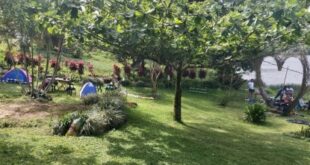Of alternatives to rice, and alternatives to war
An archaeological dig was conducted by University of Guam and the University of the Philippines Archeological Studies Program in the Old Kiyyangan Village site located in the rice terraces of Ifugao Province. The team found evidence of what the type of food people were eating during precolonial times. Based on residue analysis of the pottery sherds recovered from the site, it was determined people were cultivating, cooking by boiling, and eating the giant taro, yam, arrowroot, breadfruit, and a type of palm. There was no evidence of rice both in the form of food residue on the pots or in associated soil samples recovered from the site, which ties with other studies that approximate the date of the rice terraces to be younger than previously believed.

Dr. Stephen Acabado’s analysis dates the rice terraces to as early as 1585. The date would make the rice terraces no older than 500 years old. Acabado, along with a number of scholars, now believes “the terraced landscapes of the Ifugao are the end-result of population expansion into the Cordillera highlands in response to Spanish colonization” and presents the argument that “starchy staples were cultivated in the terraces before wet-rice cultivation.”
Other evidence recovered were animal remains indicating a diet of wild animals like deer and domesticated animals like pigs for rituals, some of which are still practiced to this day.
Even if wet rice cultivation was only introduced to the Cordilleras 500 years ago, rice in the Philippines has been around for centuries. The oldest evidence of the presence of rice in the Philippines comes from an earthenware ceramic recovered in the Lower Cagayan River Valley. Impressions of the glume—you know that leaf-like structure that envelopes each grain of rice we call the husk—was embedded in the pot along with some stem portion during the making of the pot.
Organic material like rice husks was used as temper in pot making. Temper helps keep the form of the clay and prevents it from cracking during the drying or firing process. The plant remains were identified as an intermediate between Oryza sativa and the “wild” rice variety. The pot was dated at 3,400 years, give or take 100 years. Just to compare, the oldest archaeological evidence for rice “used by humans” was found in China dating to 11,000-12,000 years.
Note that the Oryza sativa is a “cultivated rice species in Asia and the Philippines. It evolved from the wild perennial rice O. rufipogon and wild annual rice O. nivara. The Oryza sativa has been described by Dr. John C. decLeon in his paper, “Rice that Filipinos Grow and Eat” as, “an annual grass that natural and human selection transformed to become an important food crop of the world.”
Rice was wild then domesticated. According to de Leon, there are 20 other species of rice that are still wild today, four of which are found in the Philippines.
Lately, the price of rice has remained at levels that make it difficult for some households to keep it as a main staple. Our dependence on rice has led us to become the largest importer of rice in the world. With broken government promises of cheaper rice prices, one begins to wonder if we should start looking for alternatives.
Studies on food systems and behavioral patterns of Indigenous People show veering away from a rice-centered diet when environmental and economic factors make rice harder to grow and purchase. In a study conducted by Dave Buenavista et al, on alternatives to rice, ethnobotanical insights into the dietary use of edible plants by Higaonon tribe in Bukidnon Province, the Philippines, show that, “Due to limited irrigated agricultural land and expanding populations in the Bukidnon uplands, the Higaonon food system shifted from a rice-centered diet into more diverse staple crops such as sweet potato, yautia, taro, corn, cassava, and banana. The Higaonon tribe also exploited other rice substitutes, such Jacob’s tears, wild yams, and other neglected and underutilized edible plants.”
Looking down the list of the rice substitutes of the Higaonon, I see the same starch-rich food we found people in eating in the Cordillera Mountains during pre-colonial times. But are we ready for the shift? If prices of rice don’t come down in the near future, some of us may just have to.
Talking about the future: It was a point of interest how the Philippines would be able to navigate its way out of choosing sides between the People’s Republic of China (PRC) and the United States of America when it comes to the West Philippine Sea (WPS) and its bid for sovereignty over the Kalayaan Chain of islands in the disputed Spratly Archipelago (Spratlys).
Recent developments show the Philippines’ strong choice of the US as its ally along with Japan and Australia with a show of strength during quadrilateral maritime exercises held in the WPS last week. According to White House National Security Communications advisor John Kilby, “the quadrilateral maritime cooperation in the Philippines exclusive economic zone is about freedom of navigation and adherence to international law.”
The US has urged China to “abide by the Hague-based Permanent Court of Arbitration’s 2016 ruling upholding the Philippines’ sovereignty claims over parts of the Spratly’s” and cautioned China not to “overreact.” In fact, it was noted that at the same time the quadrilateral maritime exercises were being held, China held its own maritime drill.
The PRC has reiterated time and time again its “opposition to internationalize the South China Sea issue,” which the PRC claims, “should only be resolved bilaterally.”
The PRC has also made it clear that on the matter of “outside” involvement (like the involvement of the US, India, Japan, and Australia) in the dispute, to do so “will turn the matter into an ‘international or multilateral issue’” which, it warned, “would only make matters worse.”
The Philippine’s foreign policy predicament could not have been better described by then President Rodrigo Duterte’s Foreign Secretary Teodoro Locsin when he said, “No other country feels the significant impact of the rivalry between the two superpowers more than the Philippines, the US being its only defense treaty ally and China its biggest neighbor and top economic partner with US second.”
The US has promised to provide full support to PBBM’s administration “for as long as President Biden is the president” of the US. Biden is running for a second term against former US President Donald Trump.
Both Biden and Trump support freedom of navigation in the South China Sea and support the country’s claim over the Kalayaan Chain of islands. The US needs access to the South China Sea, where a big portion of “global trade passes.” This access is crucial for “international commerce, regional security, and stability” but history as well as past experience with the US has taught us Filipinos to ask, “At what cost?”
— Eliza Romualdez-Valtos
*****
Credit belongs to: www.mb.com.ph
 Atin Ito First Filipino Community Newspaper in Ontario
Atin Ito First Filipino Community Newspaper in Ontario






